
Services Offered
Traditional Asian Medicine is the extensive range of modalities under which all our services fall. It includes acupuncture procedures from China, Japan and Korea, and the wide and varied practice of Chinese herbal medicine. East Asian medicine incorporates the use of several traditional medical tools like moxibustion, cupping and gua sha. And, because East Asian medicine is currently used in modern hospitals all over the world, it incorporates advances like electrical stimulation and analyzing lab reports. At MHS, each of our practitioners uses some or all of these tools in their treatment strategies based on each individual patient's needs.
Japanese Acupuncture. Acupuncture has been used and refined for several thousand years in Japan. After WWII many Japanese Acupuncturists incorporated Western medical physiology into their practices, combining the best of the East and the West to create a new style of Acupuncture. This style extensively uses palpation of the body to verify diagnosis, point location and factors contributing to the condition. The thinking process switches from Eastern to Western theories easily, providing a more complete understanding of the underlying factors causing any pathology. Because the point location is so precise, the needling style is gentle, the needles are the smallest used in Acupuncture and the results are usually experienced by the patient during the treatment.
Acupuncture for Pain Management. Pain management is probably the most well-known reason people seek out acupuncture. Acupuncture has been used to relieve pain for at least 2 millennia and is speculated to have been used in the ancient world as early as 2500 BCE. Acupuncture for pain management has also been the subject of extensive scientific studies in modern times with 331,000 results in google scholar as of 2022.
Acupuncture is becoming more common in the West as a standard option for pain management, with more awareness in the general public and the medical community, as well as more scientific evidence showing the effectiveness of acupuncture for pain management. With doctors and the medical community looking for effective ways to treat and manage pain with low risk for negative side effects, especially in the context of the opioid crisis, many have been turning to acupuncture as the primary way of dealing with pain.
Because acupuncture is so widely studied, we now understand many of the mechanisms and effects of acupuncture in a modern medical context. Acupuncture has may affects including increasing circulation, lowering inflammation, lowering stress, increasing nerve conduction, decreasing electrical resistance on the skin, relaxing connective tissue, and more. We believe the reason acupuncture is effective for so many types of pain is due to the positive effect on so many of these systems.
Saam Acupuncture is a Korean acupuncture style originating from the 1700s. Treatments focus on addressing the most essential qualities causing one's imbalance or pain. Though Saam acupuncture may appear simple – most treatments use just four needles! – the physical, emotional, and energetic effects can be surprisingly profound. A correct treatment is immediately calming, and often provides clear, fast, lasting improvements in symptoms.
Studies have shown that Saam acupuncture's effectiveness may be due to its varying mechanisms of action that promote homeostasis within a whole person: activating the brain cortex, regulating heartrate, or balancing the sympathetic ("fight or flight") and parasympathetic ("digest and rest") nervous systems. Saam acupuncture treatments use very specific needling techniques that can have stronger needle sensations than Japanese-style acupuncture.
Yuan qi Acupuncture is taught in the U.S. primarily by Dr. Suzanne Robidoux. Originating from select teaching lineages in China and Taiwan, Yuan Qi acupuncture is an effective style primarily used for pain relief. It uses 60 points found in locations different from the usual acupoints known in Traditional Chinese medicine. It is based on Classical Chinese medicine theories, connecting the 5 elements, 6 levels, and meridian theory into correspondences that can be applied to any region of the body. Results can be instantaneous if the correct set of points is utilized.
Five Element Acupuncture is a style of acupuncture developed in mid 20th century England by Professor JR Worsley and is based on the ancient principals of Classical Chinese medicine. Treatments are focused on the alignment of body, mind, and spirit via what is known as a person's "Causative Factor," the central place from which each person lives their life. Each CF is assigned to a particular element in the Chinese 5 Element system: fire, earth, metal, water, and wood. The CF is determined by practitioners from a specific set of diagnostic criteria, namely the way a person looks, sounds, their individual set of symptoms, and the emotional threads that weave throughout their lives.
Primarily a treatment that has its greatest strengths addressing emotional health, the premise of 5 Element Acupuncture is that all illness arises when our spirit (or those inherent human characteristics that are separate from our bodies) is not fully integrated with our lives. This lack of integration is what causes imbalances in our emotional and physical bodies and is the root of all modern disease. 5 Element treatments are generally simple, needles can be retained for a time-period or simply be inserted and quickly removed; these treatments are deeply relaxing.
Muscle Testing and Reactivation identifies specific muscle groups that are underactive or overactive, and is very useful for musculoskeletal pain, daily physical function, and athletic performance. During the session, the practitioner isolates and tests every muscle surrounding the affected area to find patterns that lead to pain and movement restrictions. This helps us to find the root of the symptoms, know which muscles to reactivate, and correct the imbalance. Then the practitioner uses techniques such as Manual Muscle Reactivation or Motor Point Acupuncture to elicit a muscle fasciculation (twitch response), which “wakes up” the inhibited muscles and leads to less pain, better range of motion, and improved performance.
Motor Point Acupuncture is a form of acupuncture in which a needle is inserted directly into the muscle’s innervation region. When this technique is applied correctly, the patient often experiences a muscle fasciculation (twitch response) followed by an almost immediate loosening of the muscle if tight, or proper engagement of an inactive muscle group. Motor point acupuncture is great for treating pain, and also benefits inactive or weak muscles as is often the case after injuries or during rehab.
Kinesiology Taping, also known as Kinesiotape, is a therapy using a very specific type of stretchy tape that is applied directly to the skin in various configurations and levels of tension. Kinesiotape can help to reduce pain and swelling at the site of injury, increase mobility, prevent muscle spasms, stabilize injured or weak joints, and aid with lymphatic drainage. White Kinesiotape is a supportive therapy that works best when used in conjunction with other treatments we provide, we also offer 15-minute Kinesiology taping session that can be scheduled in-between your normal acupuncture sessions for lasting pain relief and to maximize therapeutic efficacy.
Microacupuncture is a fairly new system of acupuncture developed in Denmark in the 1980s. It is the main therapy we use for the treatment of eye and vision disorders. Each Microacupuncture session uses 2-8 out of the 48 Microacupuncture points, which are all located on the palms of hands or soles of feet. Due to their locations, the points can be painful during needling, but quickly settle; treatments are then comfortable and relaxing.
Microacupuncture is useful for many degenerative or inflammatory eye conditions such as age-related macular degeneration (ARMD), glaucoma, retinitis pigmentosa, floaters, or dry eyes. We start with a 3-week treatment course of two to four 30-minute sessions per week, after which time we assess visual parameters. If Microacupuncture is helping, patients will notice clear improvements such as more visual clarity and color distinction, better night vision, fewer floaters, or decreased eye strain. Many people also have improvements in objective parameters such as eye pressure measurements or visual field tests. With clear improvements, the treatment protocol is re-evaluated, and patient and practitioner both decide whether the "intensive" treatment schedule should continue (typically up to 10 weeks total), or if vision health is stable enough for a maintenance schedule of 1-2 treatments per month.
Microacupuncture has not been found to be helpful for non-degenerative conditions such as near- or far-sightedness, nor injury-induced vision problems especially when there is scar tissue in the eye affecting vision.
Master Tung's acupuncture. When the Chinese communist party established the People’s Republic of China in 1949, certain traditional aspects of Chinese medicine were suppressed, with some practitioners punished or imprisoned. A seasoned practitioner who had learned acupuncture through his family lineage tracing to the Han Dynasty (206 BCE to 220 CE), Master Tung (Tung Ching-Chang), fled to Taiwan and began teaching this very effective system of acupuncture, for the first time ever, to students outside of his family. His points are also known as “Tung’s magic points".
Master Tung's acupuncture points are unique because of their location—synergistic points found close together—and they strongly influence the body's fascia and connective tissue. Master Tung's acupuncture is completely different than Traditional Chinese medicine (TCM). TCM was systemized and streamlined in mainland China during that same time and is what's currently taught in China and the US. Master Tung's points have completely different names, functions and point locations when compared to TCM, and are highly effective especially for pain management.
Chinese Herbal Medicine is a rich, nuanced, holistic medical system that has been in active use for over two thousand years. Chinese herbs are almost always given as a formula consisting of 5-15 synergistic single herbs, which are selected after collecting thorough information about the whole, unique you who is being treated.
The practitioners at MHS are extremely picky about substances we put on and in our own bodies; this attention also applies to the quality of Chinese herbs we carry. We only source from suppliers such as Spring Wind, Crane, or Mayway Herbs that guarantee cleanliness, safety, and proper herbal identification. The herbs we carry pass or exceed all standards for levels of pesticides, heavy metals, and contaminants. They are herbs that we felt safe taking during our own pregnancies and give to our own families when they need.
About 70% of our patients use some form of Chinese herbal medicine during their treatment time with us. Herbs come in various formats. The most common type we dispense, chosen for its effectiveness and ability to tailor each formula individually, is powdered herbal formulas that are brewed with hot water and taken daily. Herbal pills or tablets are chosen for their convenience, and are very effective for the common cold, digestive problems, or seasonal allergy symptoms. Herbal salves, liniments, or plasters are applied topically to ease muscle and joint aches.
Chinese Herbal Medicine for Dermatology is a unique specialty within Chinese Herbal Medicine. Collecting a detailed history, current symptoms, plus careful visual examination of the skin helps determine a correct diagnosis and effective treatment. Chinese herbal medicine can yield profound and lasting results in many inflammatory and autoimmune skin conditions. The best way to show the power of Chinese Herbal Medicine for Dermatology is through photos of patient improvements over time:
Acne
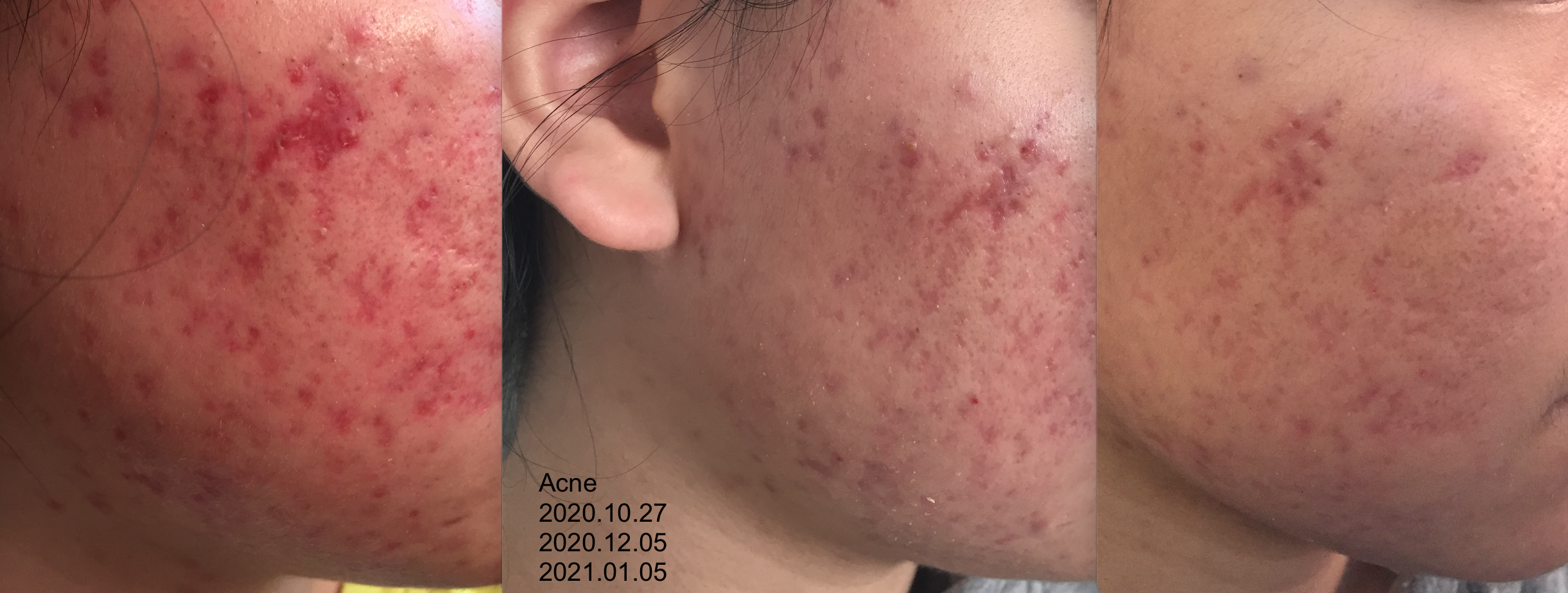
Eczema
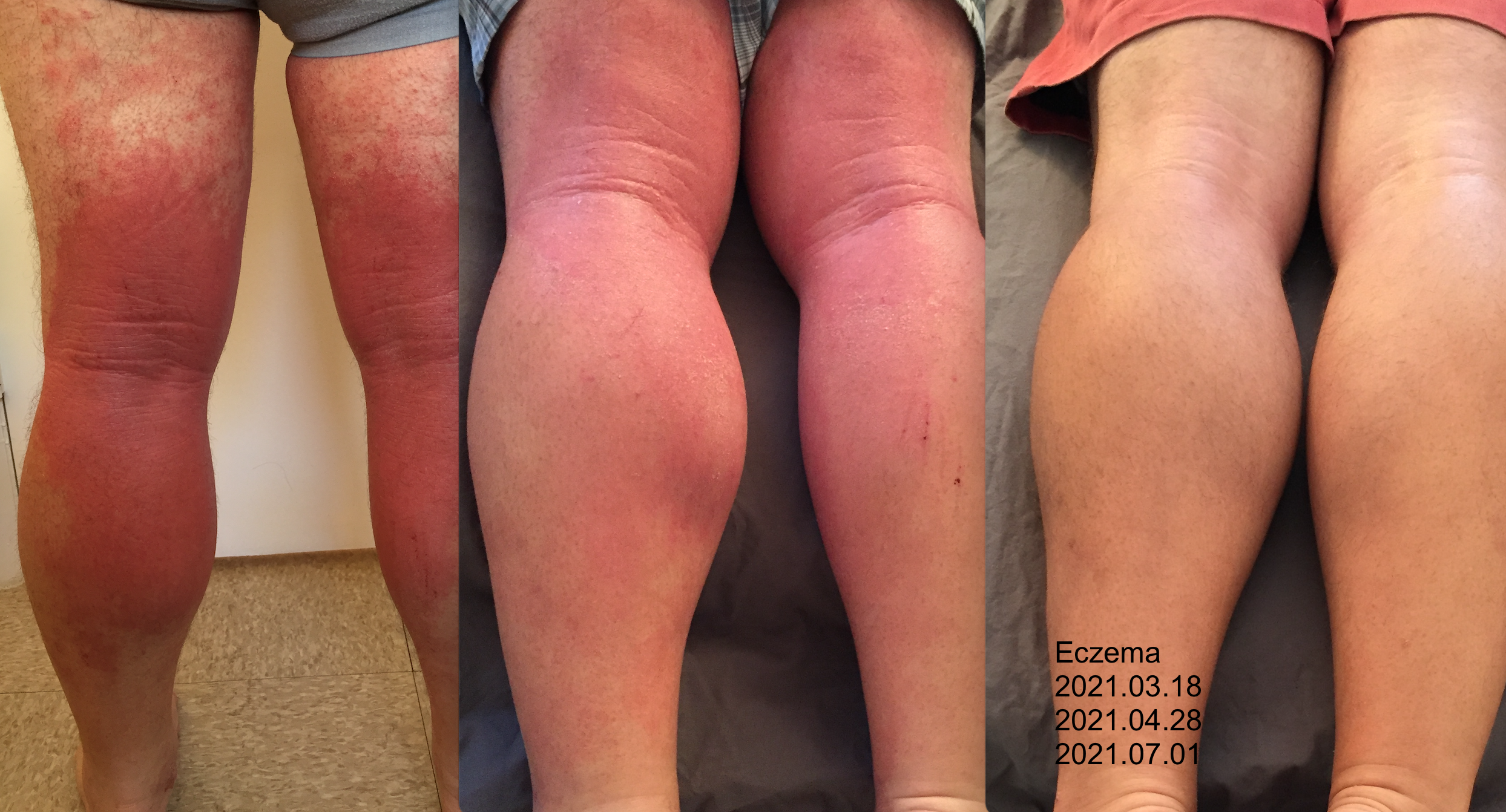
Pompholyx (Dishydrotic) Eczema
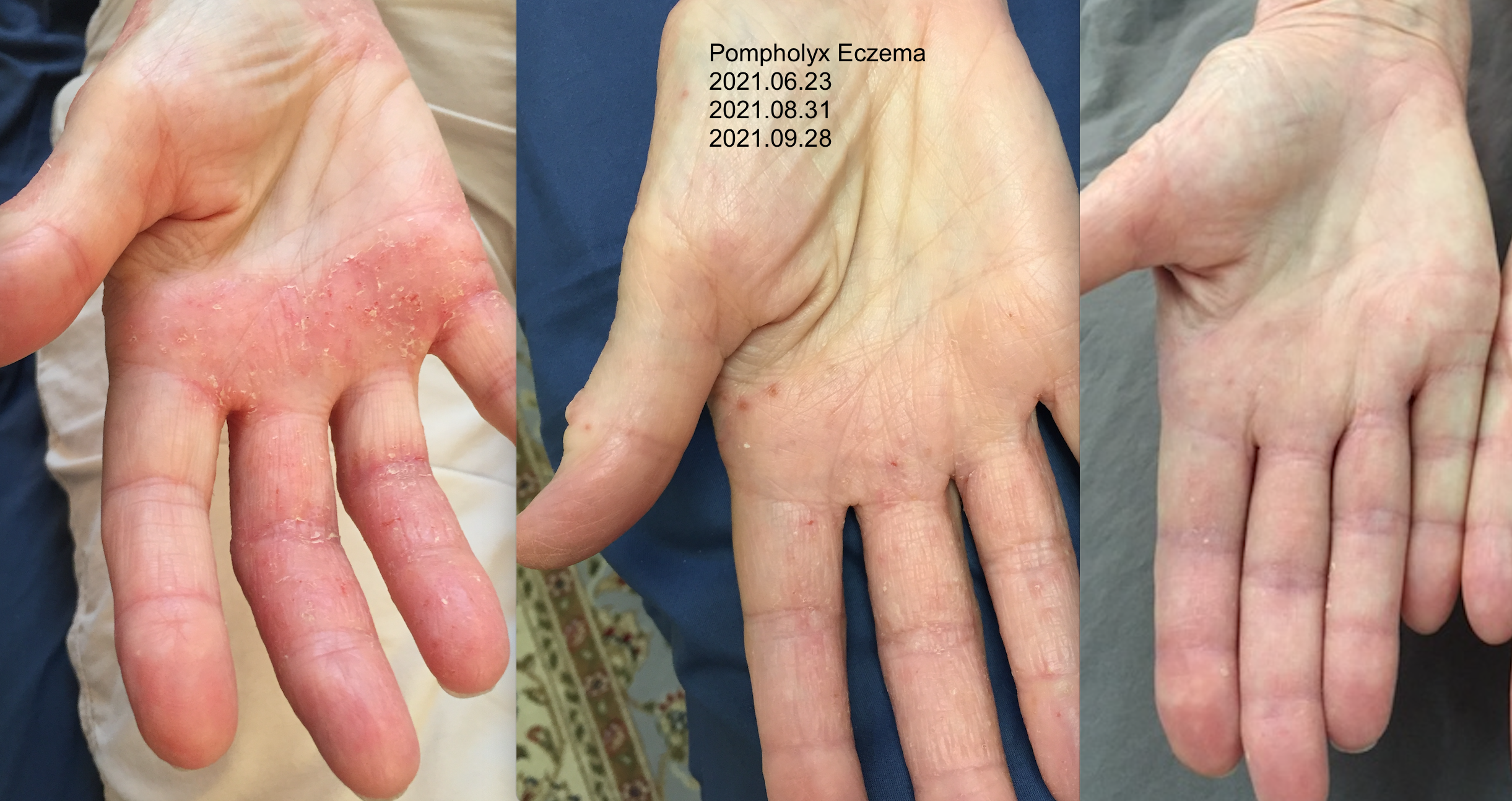
Psoriasis
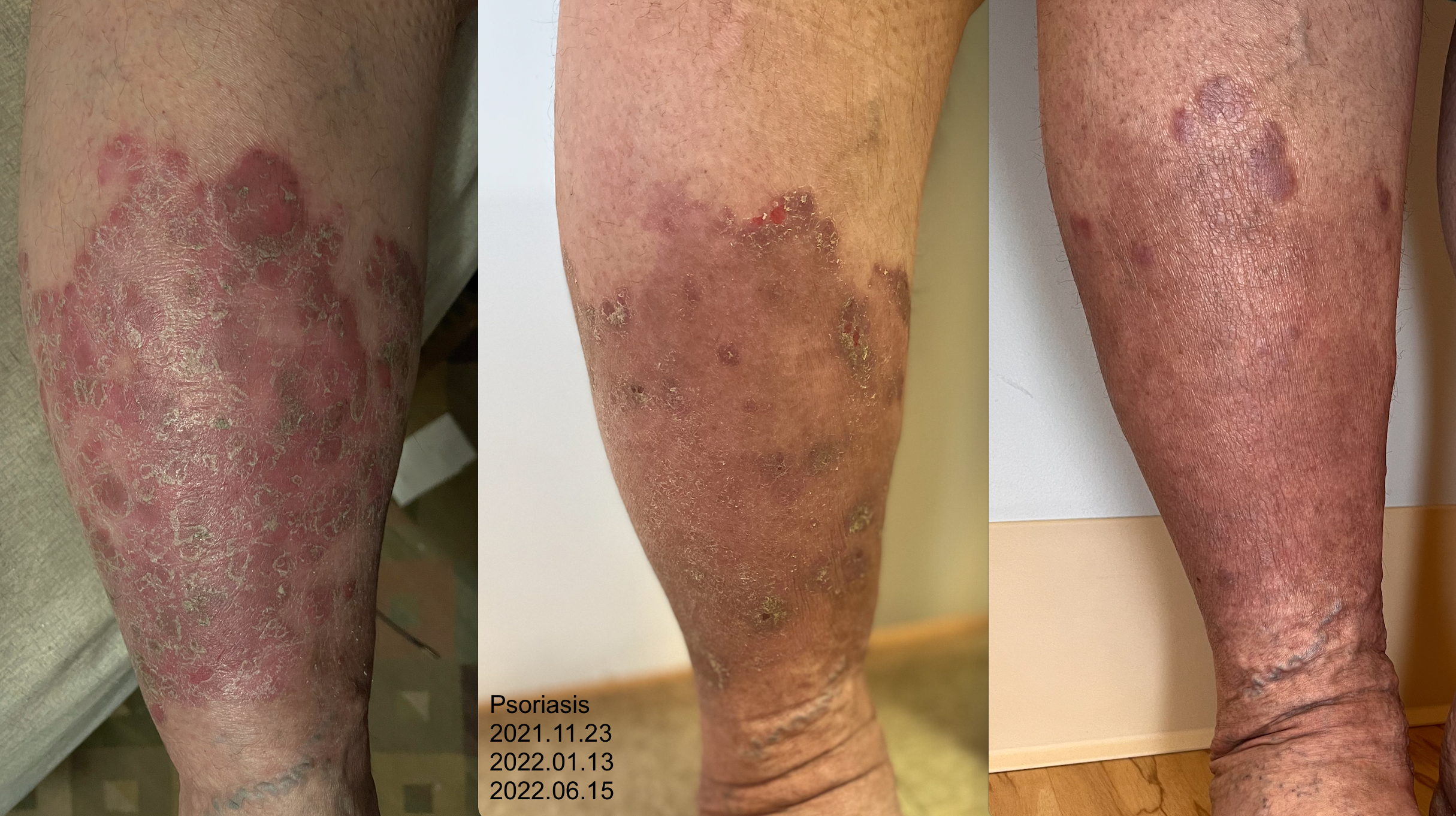
Lichen planus
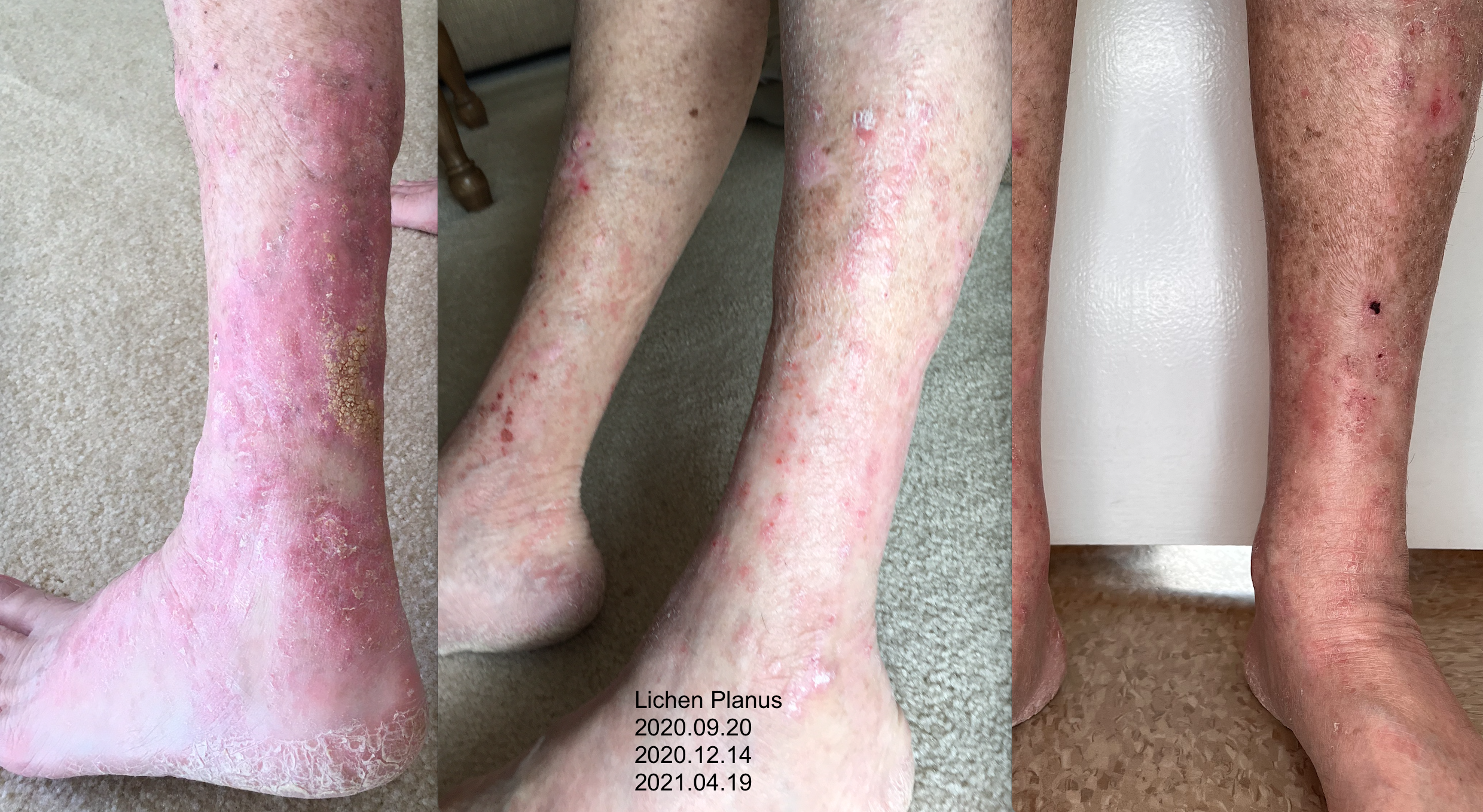
Lichen simplex
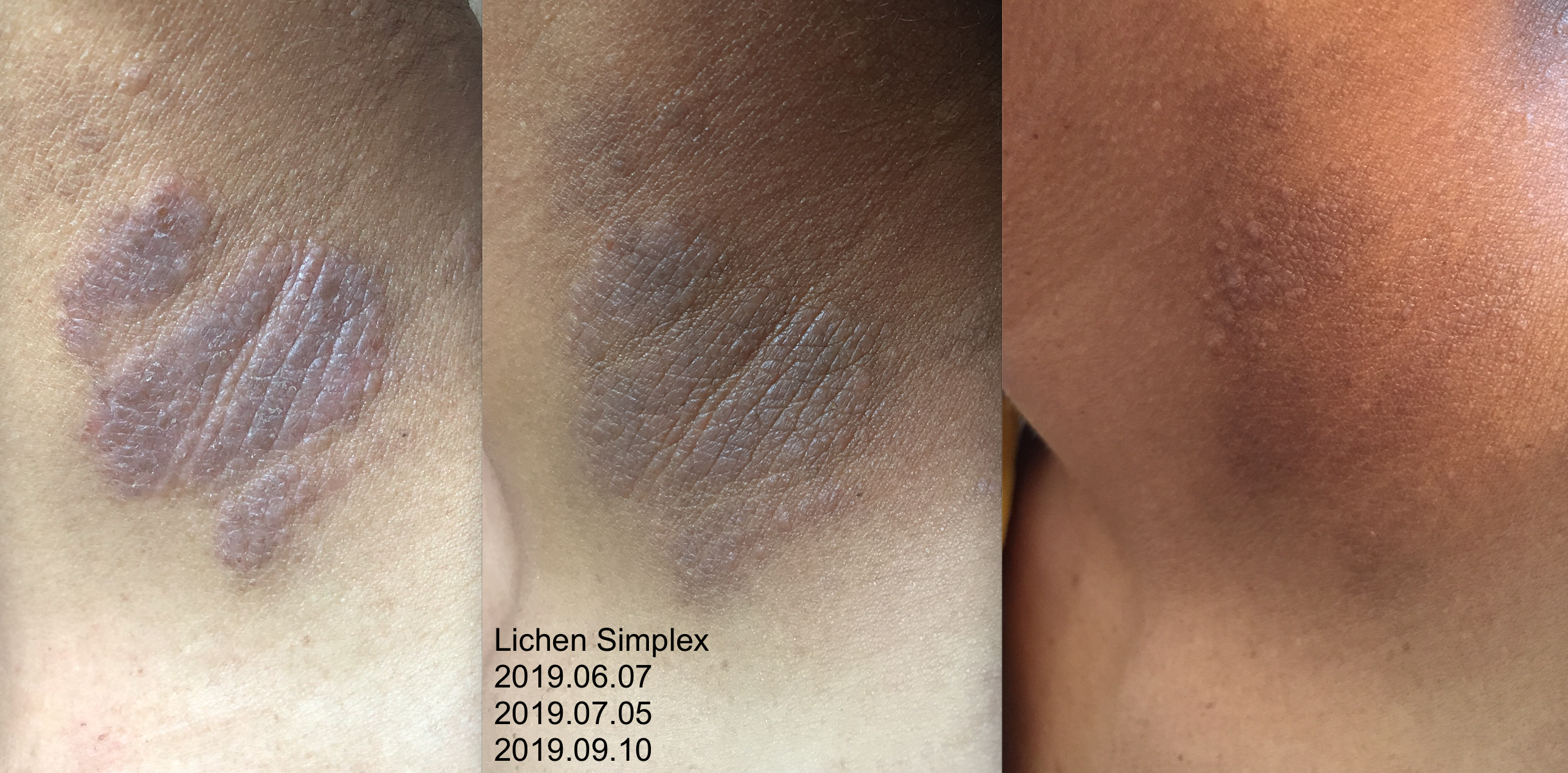
We treat the above conditions plus many others including Urticaria (hives), Fungal infections/Tinea, Herpes simplex, Rosacea, Perioral dermatitis, and Puritis.
If your skin condition is severe and especially if you have already used treatments such as high-potency corticosteroids, antibiotics, or biologics, you must be prepared to take strongly flavored (aka really gross) herbal medicine. High doses of herbs are needed daily, and the cooking process takes a lot of time, so for practical reasons, we go through Kamwo Pharmacy to cook your herbs, seal into individual doses, and ship directly to your house. Because of the high doses/specialized cooking/shipping involved, costs are also much higher than herbs we otherwise dispense. But the good news is that treatment has an endpoint!
Length of treatment depends on severity of the skin condition plus general health of the patient; 3-6 months is a typical treatment course from start to resolution of symptoms. The goal of treatment is to balance the whole person, so the skin can heal and stay healed even after stopping herbal medicine.
Functional Medicine. The Institute of Functional Medicine defines Functional Medicine as a "systems biology-based approach that focuses on identifying and addressing the root cause of disease. Each symptom or differential diagnosis may be one of many contributing to a person's illness". Functional medicine focuses on improving physiological function as a primary method of improving the health of patients with chronic disease. It is a science-based field that is grounded in the biochemistry of each individual's physiology and is patient-centered. It looks at health as a web-like interconnectedness between organ and endocrine systems which work synergistically like a finely tuned orchestra, rather than individual systems functioning autonomously and without any effect on each other.
This makes functional medicine a perfect complement to East Asian medicine which is also a systems-based model. For example, functional medicine principles tell us that digestive problems can impact neurotransmitters, thereby influencing moods, feelings and memory; thyroid imbalances affect digestion, potentially leading to poor absorption, high cholesterol, and gallstone formation; immunological factors can promote cardiovascular disease; and dietary imbalances can lead to hormonal problems. Another example is that neurons need stimulation, glucose (blood sugar) and oxygen to survive, and, for this reason, people with chronic low blood sugar and those with insulin resistance or type-2 diabetes are more prone to memory problems. By addressing any of these conditions both with foods and supplements, the brain can be nutritionally supported and neurodegeneration significantly slowed.
When we carefully interpret a patient's health history from this perspective and review their blood work, we can address health problems with Eastern methods as we have traditionally done, and also fine-tune imbalances by supporting physiology with nutrition and botanicals from a Western viewpoint. We have found that combining East and West has made our results more profound and longer-lasting.
Nutrition and Dietary Consulting. In our clinic we use principles of dietary practice from the East and the West. Using tongue and pulse diagnosis, palpation and functional lab testing we can tailor a nutritional approach specific to each person. Having adequate nutrition is mandatory for our ability to repair tissue and regulate function. Individualized nutritional protocols form a basis for all the therapeutic interventions in our clinic.
Homeopathy is based on a system that uses microdoses of substances derived from plants, minerals, or animals to stimulate a natural healing response. Homeopathy is a therapeutic system founded on the principle of "like cures like." Homeopathy is practiced worldwide, and was introduced in the U.S. in 1825, but is most popular in Europe, South America, and India.
In 1796, Dr. Samuel Christian Friedrich Hahnemann (1755 – 1843) postulated the correlation that medicines can cure a pathological state that is similar to the state that the medicine produces in healthy subjects. Originally, Hahnemann gave medicines in very large doses. These helped his patients, but produced side-effects, which he felt were due to the excessive doses. He therefore continued to reduce the dose gradually to finally arrive at ultra-diluted and succussed substances in a systematic way. This approach eliminated most side-effects.
Homeopathy complements all conventional therapies, medical or surgical, and can be used independently or together with most complementary therapies. There are no known drug-drug interactions; homeopathy is considered quite safe. Homeopathy can be used for just about any health condition, and the American Institute of Homeopathy maintains and continually updates an extensive database, available free to the public, with over 6,000 research articles, many of which are published in peer-reviewed journals.
Banerji Approach to Homeopathy. The type of homeopathy practiced here at MHS is not "classical homeopathy" which seeks to identify a patient's constitutional remedy. Instead, we use an outcomes-driven, protocol-based style from the Banerji Homeopathic Research Foundation in Kolkata, India. This homeopathic clinic sees about 6,000 patients per week that are treated by 10-12 doctors and utilizes protocols that show about 80% benefit for the complaint or disease treated. The ancestors of the late Drs. Prasanta and Pratip Banerji have collected 150 years-worth of outcomes data where specific western-diagnosed pathologies are treated with homeopathic protocols as first perceived by the late Dr. Pareshnath Banerji. This is the concept that has given birth to the Banerji Protocols which are summarized in their book "The Banerji Protocols".
The Banerji Protocols work as follows: a patient has a specific disease diagnosis with his/her unique symptomatology. One or more remedies may be selected. The patient takes these remedies for a few weeks. Based on his/her response the remedies may need to be changed until ultimately, the condition or symptoms resolve. The remedies are discontinued when normal physiology has been restored.
Dr. Schüssler's Trace Mineral Salts follow the principles of the homeopathic theory laid out by Dr. Samuel Hahnemann, the "Father of Homeopathy." Among his successors was Dr. Wilhelm H. Schūssler (1821-1898), a homeopathic physician, who was troubled by the vast array and volume of homeopathic medicines being used in the early history of homeopathic medicine. Dr. Schūssler wanted to find an easier way to use homeopathy for his patients. He carefully followed the work of Dr. Rudolf Ludwig Carl Virchow, often referred to as the "Father of Modern Cellular Pathology." Dr. Virchow taught that all diseases are based upon a change in function or condition of cells in the body. This theory led Schūssler to analyze the basic components of the body, a field of study called "cellular research."
Dr. Schūssler discovered a common pattern of twelve salts, or biochemical minerals, to be not only prevalent, but critical for healthy physiological functioning in the human body. His studies led him to conclude that dysfunctions in the human body were provoked by deficiencies in these cellular minerals. After Dr. Schüssler‘s death, as biochemical research advanced, 21 more trace mineral salts were discovered.
All life is fueled by reactions between various chemical elements which are known as nutrients. These chemical elements, also known as trace mineral salts, are needed in small amounts so our bodies can function optimally.
Trace mineral salts, in particular, help facilitate many biochemical reactions; are important building blocks for enzyme synthesis; act as builders of tissue, including connective tissue; serve as anti-oxidants; support growth and development; optimize neurological function; support the blood and vascular system; improve metabolic functions of tissues and organs; slow the oxidation or aging of tissues; are needed for hormone synthesis, and are required for normal sex organ development.
Unfortunately, hundreds of years of poor agricultural practices, including the use of inorganic fertilizers, have depleted minerals found in soil. Therefore, even if we purchase organic, local, farm-grown food it is unlikely to contain the minerals needed for optimal physiology. Without a proper cellular mineral reservoir, you couldn't think, bend at your joints, stand up straight, digest food, or eliminate toxins. Deficiency of one or more of these minerals puts your body out of balance and into "dis-ease," where your energy drops, you may experience unclear thinking or depression, or may lose emotional balance. Facial analysis aides in the diagnosis of specific minerals that may be missing in an individual. Anyone can buy and use these trace mineral salts, without fear of toxicity. This includes pregnant or nursing women, old or young alike, those taking medications, and even those using other natural therapies.
Moxibustion (Moxa) is part of the ancient Chinese medicine toolbox and is used externally to treat a range of diseases. The procedure involves burning the herb mugwort (artemisia vulgaris) near or on the skin and is typically used in addition to needles during an acupuncture treatment. A safe, effective, and well-studied modality, moxa can greatly enhance the benefits of an acupuncture treatment and is used often in the treatment of pain, digestive disorders, fertility and menstrual disorders, and even in pediatrics. Perhaps the most well-known use of moxa is in the treatment of breech presentation during pregnancy. The skin is treated either directly with small grain-sized bits of the herb placed directly on the skin, or indirectly using small incense sticks or large sticks rolled with the herb, to warm the area and produce certain effects. The thermal properties of burning moxa combined with the pharmacologic effects of the herb itself are what give moxibustion therapy its efficacy.
E-stim and Micro-current Therapy. Electrical stimulation (milli-amperage stimulation, or TENS) and Micro-current therapy are both tools used for extra benefit in treatment. TENS has been used world-wide for decades to help control pain, is widely available, inexpensive and can be very effective in pain control.
Micro-current therapy uses millionths of an Ampere levels of stimulation that are designed to work with the body's existing electrical physiology to enhance our capacity to repair injury or enhance function. Micro-current therapy was developed in the US and is FDA registered for the treatment of pain, depression, anxiety and insomnia. This level of current is felt quite gently, if at all, and increases the capacitance in the cell wall, enhancing the cell's ability to function. Ongoing research continues to reveal new benefits to Micro-current therapy.
Cupping has been gaining popularity in recent years. It's common now to see images of dark circles on Olympic athletes who've used cupping to treat muscle pain, or of a model with beautiful skin promoting facial cupping. It may (or may not) surprise you to learn that cupping has been practiced for centuries!
Cupping is a technique where cups or bowls are place on the body using suction. Cups are made of a variety of materials including glass, silicone, porcelain, plastic, and more. And the suction is created with a pump or in fire cupping by using a small flame to create a vacuum inside the cup. Cupping is an effective technique to relieve pain, increase circulation, and promote healing. There are cups or different sizes and shapes for different areas of the body. Different techniques may be used such as sliding or leaving the cups in a stationary position, and oils can be used on the skin to help adhere the cup and prevent discomfort.
Depending on the goal, cupping is used differently for different applications. For example, in facial cupping the goal is to increase circulation to the facial skin and muscles in order to increase circulation and collagen, therefore suction is light, the cups are small with various shapes to fit the contours of the face, and usually are not left stationary to avoid the dark markings that can occur from cupping, and the oil used will be a moisturizer that is safe to use on the face. On the other hand, cupping to relieve pain back will usually be larger, the suction stronger, the cups often leave marks, and the oil is often an analgesic balm to help increase the pain relief.
The marks left by cupping resemble bruises and people often assume the marks are painful. The opposite is actually true, while the marks look like bruises, they are not painful like bruises. In fact, the areas where the cup marks are present are usually the area with significant pain relief.
Guasha is a technique where a variety of tools including stones such as jade, ceramic tools, or metal are run along the skin in a scraping motion. Recently guasha has been increasing in popularity for its ability to rejuvenate the skin. Guasha is also used to relieve pain and promote healing.
Much like cupping, the technique used during guasha depends on the intended goal. For facial guasha the tools are usually a cool stone such as jade cut into various shapes to fit the contours or the face and will have a very gentle edge to protect the skin, the oils used will be gentle and safe to use on the face, and the pressure will be gentle to avoid leaving marks. Guasha for neck tension will often use ceramic, bone or metal tools that are stronger to withstand more pressure, usually have more stark angles to get deeper into the muscles, the oil used is often an analgesic balm to increase pain relief, and the pressure applied is stronger and often leaves marks.
Just like cupping the marks left from guasha resemble bruising and, also like cupping, they are rarely painful. Cupping and guasha markings can vary in color from light pink or red, to a deep crimson, to dark purple verging on black. These are all normal! In fact, these marks help inform your practitioner about the depth and severity of your condition.
Massage Therapy services at Meridian Health Solutions are offered by Licensed Massage Therapy and Bodywork practitioners with extensive experience. Many types of massage and various depths of pressure can be employed, depending on each client's needs and circumstances. Services may include Craniosacral Therapy, Myofascial Relief, Trigger Point Therapy, and Reflexology. Our practitioner is certified in Prenatal Massage, and safely works with people throughout pregnancy.


